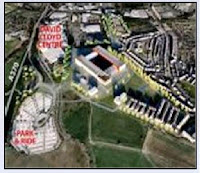
New plans will involve drawings and pictures and/or three dimensional models, these days often computer generated. The plans for a new Bristol City stadium are no exception to this (see aerial view left) - many have been featured very prominently and repeatedly in the local press (eg here) as well as in the architects report (here) and on the Bristol City FC website (here). Pictures are familiar and require little specialist training to interpret, making them a powerful communications tool (which developers, planners, councils and the media are of course well aware of).
 Pictures are useful - but the viewer should consider both what is shown and what is not shown. Viewers need to weigh up how representative and realistic what someone has chosen to present to them for their chosen purpose, not necessarily the viewers purpose, truly is. People usually see things from the ground yet we are often given aerial views (as above) and not shown the view from residents back gardens (as is the case with the computer-generated pictures of the proposed Bristol City stadium the Evening Post has prominently featured).
Pictures are useful - but the viewer should consider both what is shown and what is not shown. Viewers need to weigh up how representative and realistic what someone has chosen to present to them for their chosen purpose, not necessarily the viewers purpose, truly is. People usually see things from the ground yet we are often given aerial views (as above) and not shown the view from residents back gardens (as is the case with the computer-generated pictures of the proposed Bristol City stadium the Evening Post has prominently featured).Many images we are presented with are shown in isolation or with the visual context that those producing the pictures want to give. The picture above shows one approach to the proposed Bristol City stadium which includes: a) very large, mature trees that would take years to grow b) a couple with the children just behind them. None of the images of the proposed stadium I've seen show any traffic or crowds whatsoever. Its not that the images we are presented with are 'wrong' its that they are partial and are selected to show what a narrow range of people want us to see!!